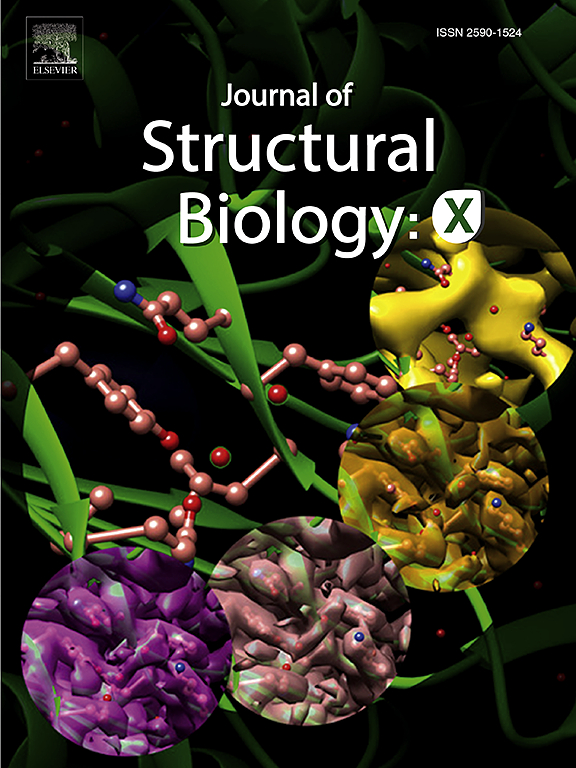Cryo-iCLEM: Cryo correlative light and electron microscopy with immersion objectives
IF 2.7
3区 生物学
Q3 BIOCHEMISTRY & MOLECULAR BIOLOGY
引用次数: 0
Abstract
Correlative light and electron microscopy (CLEM) is a powerful tool for investigating cellular structure and function at the molecular level. However, while electron microscopy is often performed to great advantage at cryogenic temperatures, this is not always the case for light microscopy. One key challenge is the lack of cryo-compatible immersion objectives. In recent years, multiple cryoimmersion light microscopy (cryo-iLM) approaches have been described, but these techniques have never been used in correlative approaches. Here we present a novel workflow for correlative cryoimmersion light microscopy and electron cryomicroscopy (cryo-iCLEM). Cryo-electron tomography conducted before and after cryo-iLM reveals that cryo-iCLEM maintains ultra-thin, electron-transparent samples mechanically intact and does not degrade the ultrastructural preservation achieved through plunge-freezing. For cryo-iLM, the sample is first embedded in a viscous immersion medium at cryogenic temperatures and examined with a custom cryo-immersion objective. After cryo-iLM, the immersion medium is dissolved in liquid ethane, allowing for subsequent cryo-EM imaging. We further show that cryo-iCLEM can be used on FIB-lamellae, demonstrating that mechanically sensitive samples remain undamaged. Embedding the sample in the immersion fluid reduces contamination and thus allows data acquisition over many hours. Samples can therefore be examined in detail with the advantage of low bleaching rates of fluorophores at cryogenic temperatures. In the future, we hope that our approach can help improve the performance of many advanced light microscopy techniques when they are applied in the context of cryo-CLEM.

Cryo- iclem:带浸没物镜的低温相关光学和电子显微镜。
相关光电子显微镜(CLEM)是在分子水平上研究细胞结构和功能的有力工具。然而,虽然电子显微镜通常在低温下具有很大的优势,但光学显微镜并不总是如此。一个关键的挑战是缺乏与低温兼容的浸入目标。近年来,已有多种低温浸光显微镜(cryo-iLM)方法被描述,但这些技术从未在相关方法中使用。在这里,我们提出了一种新的工作流程,用于相关的冷冻浸泡光学显微镜和电子冷冻显微镜(cryo-iCLEM)。在冷冻- ilm前后进行的冷冻电子断层扫描显示,冷冻- iclem保持了超薄、电子透明的样品的机械完整性,并且不会降低通过浸入式冷冻获得的超微结构保存。对于低温ilm,样品首先在低温下嵌入粘性浸入介质中,并用定制的低温浸入物镜进行检测。在冷冻- ilm后,浸泡介质溶解在液态乙烷中,允许随后的冷冻- em成像。我们进一步表明,cryo-iCLEM可以用于fib片层,表明机械敏感样品保持完好无损。将样品包埋在浸渍液中可以减少污染,因此可以在许多小时内获取数据。因此,可以对样品进行详细检查,其优点是在低温下荧光团的漂白率低。在未来,我们希望我们的方法可以帮助提高许多先进的光学显微镜技术的性能,当他们应用于低温clem的背景下。
本文章由计算机程序翻译,如有差异,请以英文原文为准。
求助全文
约1分钟内获得全文
求助全文
来源期刊

Journal of structural biology
生物-生化与分子生物学
CiteScore
6.30
自引率
3.30%
发文量
88
审稿时长
65 days
期刊介绍:
Journal of Structural Biology (JSB) has an open access mirror journal, the Journal of Structural Biology: X (JSBX), sharing the same aims and scope, editorial team, submission system and rigorous peer review. Since both journals share the same editorial system, you may submit your manuscript via either journal homepage. You will be prompted during submission (and revision) to choose in which to publish your article. The editors and reviewers are not aware of the choice you made until the article has been published online. JSB and JSBX publish papers dealing with the structural analysis of living material at every level of organization by all methods that lead to an understanding of biological function in terms of molecular and supermolecular structure.
Techniques covered include:
• Light microscopy including confocal microscopy
• All types of electron microscopy
• X-ray diffraction
• Nuclear magnetic resonance
• Scanning force microscopy, scanning probe microscopy, and tunneling microscopy
• Digital image processing
• Computational insights into structure
 求助内容:
求助内容: 应助结果提醒方式:
应助结果提醒方式:


